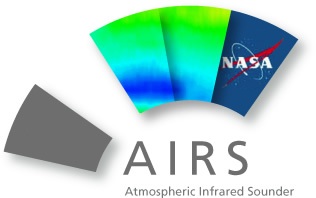
AIRS

The Atmospheric Infrared Sounder was launched on board of NASA's Aqua satellite on May 4, 2002 from Vandenberg Air Force Base. AIRS, together with the Advanced Microwave Sounding Unit, AMSU represents the most advanced sounding system ever deployed in space. The system is capable of measuring the atmospheric temperature in the troposphere with radiosonde (weather balloons) accuracies of 1 K over 1 km-thick layers under both clear and cloudy conditions, while the accuracy of the derived moisture profiles will exceed that obtained by radiosondes. Furthermore, the system is providing additional data on land and ocean surface temperature and surface emissivity, cloud fraction, cloud top height, and ozone burden of the atmosphere. This makes AIRS/AMSU the primary observing system to study the global water and energy cycles, climate variation and trends, and the response of the climate system to increased greenhouse gases.
Objectives
Understanding the dynamics of climate, the transport of chemical agents in the atmosphere and their distribution over the surface of the Earth, and the rainfall and evaporation that control the growth of vegetation requires a precise knowledge of the global atmospheric circulation, temperature profiles, and water vapor content. AIRS and it's companion microwave sounder AMSU are observing and characterizing the entire atmospheric column from the surface to the top of the atmosphere in terms of surface emissivity and temperature, atmospheric temperature and humidity profiles, cloud amount and height, and the spectral outgoing infrared radiation. These data and scientific investigations will answer long-standing questions about the exchange and transformation of energy and radiation in the atmosphere and at the Earth's surface.
Main AIRS Science Objectives:
- Determination of the factors that control the global energy and water cycles
- Investigation of atmosphere-surface interactions
- Improving numerical weather prediction
- Detection of the effects of increased greenhouse gases
- Assessing climate variations and feedbacks
Instrument
The Atmospheric Infrared Sounder (AIRS), an advanced sounder containing 2378 infrared channels and four visible/near-infrared channels, aimed at obtaining highly accurate temperature profiles within the atmosphere plus a variety of additional Earth/atmosphere products. AIRS will be the highlighted instrument in the AIRS/AMSU-A/HSB triplet centered on measuring accurate temperature and humidity profiles throughout the atmosphere.
Instrument characteristics:
- High-spectral resolution, grating multispectral infrared sounder operated in a cross-track-scanning mode with AMSU-A and HSB for all weather capabiity.
- Measure's the Earth's outgoing radiation at 0.4 to 1.0 µm and 3.7 to 15.4 µm.
- 1 K temperature retrieval accuracy per 1 km layer in the troposphere.
- 0.05 emissivity accuracy.
- Array grating spectrometer (3.74 to 15.4 µm), with a spectral resolution of 1200 (λ / Δλ)
Instrument facts:
| Band | Wavelength (µm) | Resolution (m) | Swath Width (km) | Revisit time (days) |
|---|---|---|---|---|
| Band 5 (MWIR) | 3.74 to 4.61 | 13500 (1000) | 1800 | 0.5 |
| Band 6 (TIR) | 6.2 to 8.22 | 13500 (1000) | 1800 | 0.5 |
| Band 7 (TIR) | 8.8 to 15.4 | 13500 (1000) | 1800 | 0.5 |
| Band 1 (VIS) | 0.4 | 13500 | 1800 | 0.5 |
| Band 2 (VIS) | 13500 | 1800 | 0.5 | |
| Band 3 (VIS) | 13500 | 1800 | 0.5 | |
| Band 4 (NIR) | to 1 | 13500 | 1800 | 0.5 |
Data Access
General Data Product Level Definition
AIRS is a "facility instrument", meaning it is part of the Earth Observing System Facility and there is no Principal Investigator. As such, data coming from the instrument is freely available to all who request it. And AIRS data is truly free. In contrast to data from many other instruments, there is no fee to use the data. In addition, the AIRS Project is here to support the AIRS data users.
AIRS product data could be accessed from National Oceanic and Atmospheric Administration Global Climate Monitoring.
The Aqua Platform
NASA's Aqua spacecraft was launched on May 4, 2002 at 2:55 a.m. PDT aboard a Delta II 7920-10L launch vehicle from the Vandenberg Air Force Base, California. On board the Aqua spacecraft, the Atmospheric Infrared Sounder (AIRS) instrument provides data that is being used by scientists around the world.
Aqua is focused on the multi-disciplinary study of Earth's interrelated processes (atmosphere, oceans, and land surface) and their relationship to changes in the Earth system. The global change research efforts emphasized with the Aqua instrument data sets include:
- atmospheric temperature and humidity profiles, clouds, precipitation and radiative balance;
- terrestrial snow and sea ice; sea surface temperature and ocean productivity;
- soil moisture;
- and the improvement of numerical weather prediction
Aqua is also making critical contributions to the monitoring of terrestrial and marine ecosystem dynamics.
Links
- Official AIRS site.
- Official AQUA site.
- more information about AIRS,with its companion Advanced Microwave Sounding Unit (AMSU) and Humidity Sounder for Brazil (HSB) could be found here.
- Data product summary
Contact
If you would like to have more information about the AIRS data, please contact wdc@dlr.de